

The Thames through London is tidal and consequently twice a day the tide moves up and down the River. This movement causes the mud on the River bed to be continually stirred up giving the river its ‘dirty’ brown and murky appearance as the silt becomes suspended in the water. But, contrary to popular belief, the river is not polluted. The water quality is very good and in fact the tidal Thames is now acknowledged to be one of the cleanest metropolitan rivers in the world. But this has not always been the case. There was concern about the pollution of the tidal Thames as far back as Medieval times when an Act of Parliament in 1383 ordered that anyone with latrines over the Wallbrook Stream (a small tributary of the Thames in central London) would have to pay 2 shillings a year towards the cost of cleaning up the River. There was another Act in 1388 making it illegal to pollute ditches, rivers, water and the air of London. In 1535, at the time of Henry VIII, a further Act was passed prohibiting the casting of rubbish and pollution into the Thames. However, with no means of enforcement and a growing population with no means of disposing of its waste, the Acts were rather ineffectual.
Despite this, as late as 1800 records show that nearly 3000 salmon per year from the Thames were being sold in London fishmarkets. However, the last salmon, until fairly recently, was recorded upstream of London Bridge in 1833.
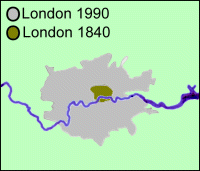 |
The 1841 census showed that there were 270,000 houses in Central London. It is most likely that all of these houses would have had cesspits which, more often than not, overflowed. Consequently, the tidal Thames was considerably polluted. |
Map 1 - The Growth of London |
By this time the Industrial Revolution was well under way and an increasing number of factories, slaughter houses, tanneries and other industries grew up along the banks of the River. This, together with a growing population, led to an increase in pollution from industrial wastes and overflowing cesspits.
Two key events finally spelt the destruction of the Thames - the rapid increase in the use of the water closet (which dramatically increased the volume of water borne waste) and the the requirement in the Metropolitan Building Acts 1844 & 1847 that all new buildings be connected to the common sewers. This meant that more and more waste from the population of London went directly into the River untreated and by 1849 fish had disappeared from the tidal Thames. At that time water was still being abstracted from the Thames for public consumption and cholera was rife.
Between 1831 and 1866 there were 4 cholera epidemics during which over 35,000 people died, but it was not until the third epidemic in 1853/4 that cholera was linked to the water supply. It was at this time that the clean up began.
In 1855, the eminent scientist Michael Fariday wrote to 'The Times' regarding the appalling state of the River Thames. In it he wrote '....surely the River which flows so many miles through London, ought not to be allowed to become a fermenting sewer...'
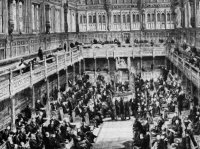 |
In 1858 a heatwave occurred and the disgusting smell from the River caused so much disruption to Members of Parliament that they hung sheets soaked in chloride of lime from the windows of the House of Commons. In addition, many tons of chalk lime, chloride of lime and carbolic acid were tipped into the Thames but with little or no effect. This became known as the year of the 'Great Stink'. |
House of Commons |
Immediately prior to this, between 1848 and 1855, six successive Commissions were set up to seek a solution to the pollution problem. In 1855 the last Commission was replaced by the Metropolitan Board of Works who considered many proposals. After much debate and acrimony, it was the plan of the Board's own Chief Engineer, Joseph Bazalgette (later Sir), which was finally adopted. This scheme involved the construction of a network of sewers on both sides of the river running down to outfalls at Beckton on the north bank and Crossness on the south bank. |
 |
The Bazalgette Monument on the Embankment |
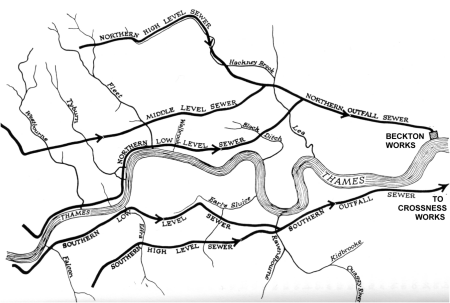 |
Map 2 - Bazalgette's Intercepting Sewer Network |
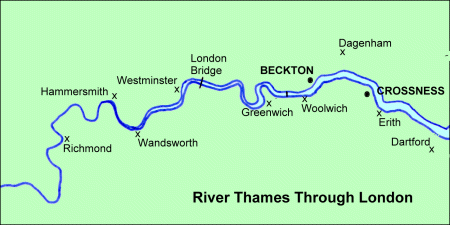 |
Map 3 - Location of the Beckton & Crossness Works |
It was considered by the Board that these were far enough downstream not to cause offence as sewage was to be discharged on the ebb tide from large storage tanks. There was criticism of the scheme by some who thought the outfalls should be placed further downstream but in 1858, following the 'Great Stink' which concentrated the minds of the politicians, the Board was absolved from the need to obtain Government approval and at the same time made exempt from the control of the Thames Conservancy set up the previous year. The scheme therefore went ahead as originally planned and was completed in 1864. It was officially opened by the Prince of Wales in 1865.
The scheme did lead to an improvement in the River in Central London but the problem was transferred downstream to Barking adjacent to the outfalls where large mud banks were building up.
In 1878 the Thames pleasure Steamer'Princess Alice', with about 800 people on board, sank, with the loss of 600 lives, in the vicinity of the Beckton outfall after colliding with another vessel the 'Bywell Castle'. An Inquiry into the accident found that the deaths had been accelerated by the putrid state of the water.
A Royal Commission was appointed in 1882 to look into the state of the River around the Outfalls and this resulted in new treatment methods being introduced at both Beckton and Crossness. This involved the settling out of the solid matter from the sewage effluent and its subsequent disposal at sea.
In 1889 the Metropolitan Board Of Works was replaced by the London County Council which carried out an examination of the whole system. Improvements were made to the capacity of the sewers and new intercepting sewers were constructed to reduce the discharge of storm overflows.
At last, in the late 1890's, there were reports of a much cleaner River and an increase in fish life. But London continued to grow and as the population and number of industries grew so did the pollution. Tributaries of the Thames were becoming severly polluted due to the geographic sprawl of London and in the 1930's complaints were once again being voiced about the unsatisfactory state of the River.
During the Second World War bomb damage to sewers and sewage treatment works throughout London lead to further pollution which was made worse by the widespread use of non-biodegradable detergents. By the 1950's, the combined effect of sewage effluent, industrial discharges and thermal pollution from power stations and gas works, produced a River that was virtually dead. Water quality was so poor that during summer months large stretches of the River were devoid of any oxygen with the result that there was no established population of fish between Fulham and Tilbury.
Following the report prepared for the Thames Survey Committee in 1961 by the Pollution Research Board and the report of Professor Pippard in the same year, improvements to sewage treatment works and the diversion of some industrial discharges from the River, gradually brought about a cleaner River and in 1974 salmon returned to the Thames - the first for 150 years!
 |
Salmon |
The life cycle of the Salmon requires a high standard of water quality in the whole of the catchment. Salmon spawn in the upper freshwater tributaries producing young salmon which then migrate to the feeding grounds at sea. On reaching the sea, Salmon grow rapidly and after one to three years they make their return journey to their home river to spawn and continue the cycle. Such a life cycle requires good environmental conditions in the sea, the estuary, the river and its tributaries. The Salmon has fastidious requirements which makes the species an excellent indicator of environmental quality.
In 1979 the Thames Salmon Re-habilitation Scheme was launched in conjunction with the Thames Salmon Trust with the long term aim of restoring a self sustaining Salmon population in the River Thames. The Scheme involves fish rearing and stocking, the construction of Salmon ladders in the weirs upstream in the non-tidal Thames and a programme of evaluation. The last Salmon ladder to be built on the Thames was opened at Boulters Weir on 19 May 2000 by the Duke of Wellington. This completed the current programme and all the weirs from Teddington to Mapledurham now have ladders installed.
The Scheme has been successful with a sustained regular run of Salmon since 1982 with a record return of 338 Salmon in 1993. This is despite the fact that the migratory period for the returning Salmon is April to November, with the key period being July and August, which coincides with the period of reduced environmental quality on the tidal Thames due to reduced river flows and increased water temperatures. Unfortunately, since 1993 the numbers of returning Salmon have declined but there are still around 50 a year returning.
Not only have the Salmon returned: in the last 25 years some 120 species of fish have been recorded in the River Thames including 20 species of freshwater fish, 14 euryhaline fish (fish that can tolerate both salt and fresh water) and 86 marine fish. These include Smelt (perhaps the most unusual and internationally recognised as rare), Bass, Twaite Shad, Sea Lamprey and Allis Shad all of which need a clean river for part of their life cycle. Their presence in the River is of great ecological value.
Furthermore, the tidal Thames supports over 350 species of invertebrates, 38 species of bird and 300 plant species.
 |
 |
 |
Smelt |
Ragworm |
Tufted Duck |
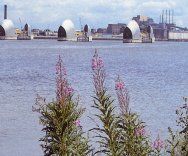 |
Rosebay Willowherb |
The tidal Thames is also the largest nursery ground for Sole in England and Wales and for Bass in the southern North Sea.
And over the last few years, seals have been spotted fairly frequently swimming up the Thames through central London and up as far as Richmond and Teddington. Again, it is thought that the cleaner waters are encouraging the seals up the River.
Despite these great improvements in water quality in the tidal Thames, there is still a potential danger in the summer months due to 'Combined Sewer Overflows' (CSOs). Much of central London is served by a combined drainage system. This means that both wastewater from domestic and industrial premises (foul water) and rainwater from roads and roofs (surface water) are collected in the same sewerage system. The benefit of this system is that any polluting spillage on a road or hardstanding in a factory will be treated before it is discharged. The disadvantage is that during periods of heavy rain over London the sewers havn't sufficient capacity to take the combined flows and the CSOs come into operation.
These CSOs, which contain a mixture of sewage and rainwater run-off, come into operation as often as 60 times a year discharging an estimated 20 million cubic metres of storm sewage annually into the River. These discharges can be very polluting and offensive in the River and on the foreshore and can increase the health risk for recreational users of the river. There are 57 CSOs between Chiswick and Beckton of which 36 have been identified by the Environment Agency as 'unsatisfactory' in terms of frequency of discharge and/or environmental impact and it is these 36 that cause the vast majority of the polluting load into the tidal River.
During summer months, when the River flows are low, this polluting load can have a severe effect on water quality as the oxygen in the water is rapidly depleted causing an acute oxygen 'sag' in the reach of the river where the storm sewage is discharged. In the most severe cases the oxygen may fall to near zero which can result in fish deaths. The severity of the problem was demonstrated in on 3 August 2004 when, following torrential storms in central London, some 600,000 tonnes of untreated sewage and urban run-off (surface water from roads and roofs) were discharged into the Thames causing the deaths of thousands of fish in a single day.
The Thames Tideway Strategy Group, comprising representatives from Thames Water, the Environment Agency (EA), Ofwat (The economic regulator for the water and sewerage industry in England and Wales), the Department for the Environment, Food and Rural Affairs (DEFRA) and the Greater London Authority (GLA), was set up in 2000 to assess the environmental impact of these CSOs, to identify objectives for improvement and to prepare potential solution having regard to cost.
This Group published and circulated its report to DEFRA and Ofwat in February 2005. The preferred option identified by the Steering Group is Option - A (Refined) and would involve the construction of a 34.5km (21.5 mile) long storage and transfer tunnel running mainly beneath the River Thames from Hammersmith in west London to intercept and carry the disharges from the 36 unsatisfactory CSOs to the Crossness Sewage Treament Works for collection and treatment. The main tunnel would 7.2m in diameter. Two further link tunnels would also be constructed: a 4.5 km tunnel, 5m in diameter, from the Abbey Mills Pumping Station and a 1.1km tunnel, 3m in diameter, from the Becton STW. The estimated cost of the total scheme, at 2004 prices, is approximately £1,700 million. However, while Ofwat's recent determination of water price limits for the period 2005 - 2010 will provide for necessary upgrades to London's existing sewage treatment works, no provision has been made for this proposed long term solution. It is now for the Government and Ofwat to decide on the way forward.
 |
Map 4 - The Preferred Option |
When in the 1980's it was decided that the cost of improving London's sewerage system to eliminate the problem of these CSOs could not at that time be justified and that excessive disruption would arise, alternative solutions had to be found. It transpired that the direct injection of oxygen into the River at the right time and at the right place was the only practicable solution.
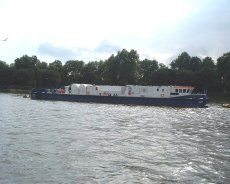 |
The Thames Vitality |
Consequently, in 1989 a purpose built vessel,the 'Thames Bubbler' came into operation. It injects up to 30 tonnes of oxygen per day directly into the River at the appropriate time and place. It is 50.5 metres long and 10 metres wide. It cost £3.5 million to build and costs around a £0.25 million a year to operate. A new oxygenation vessel, the 'Thames Vitality' with the same capacity as the 'Thames Bubbler' was launched in 1997. Both these vessels are owned and operated by Thames Water Utilities as part of an operating agreement with the Environment Agency and can be deployed within a few hours notice if it appears likely that oxygen levels will fall to critical levels. The vessels were deployed on 24 days in 2000, 30 days in 2001, 48 days in 2002, 25 days in 2003 and 29 days in 2004.
In addition to these two vessels, two installations have been built, one at Barnes sewage treatment works and the other at Pimlico pumping station, which store hydrogen peroxide which is released into the River as an additional oxygenation source as and when necessary.
Until the final solution to this problem is agreed, the current mitigation procedures will continue.
The Environment Agency also have two patrol boats on the tidal Thames, 'Thames Champion' and 'Thames Guardian'. 'Thames Champion' is used mainly for flood defence inspections whilst 'Thames Guardian' is used for monitoring water quality and is used by scientists from the Environment Agency as well as from London University.
The clean up of the tidal Thames has been a considerable achievement. The challenge now is to ensure that this achievement is maintained.
The Environment Agency's free 24 hour emergency hotline telephone number for reporting pollution incidents is:
To return to The River Thames page Click Here
Copyright © The Harts